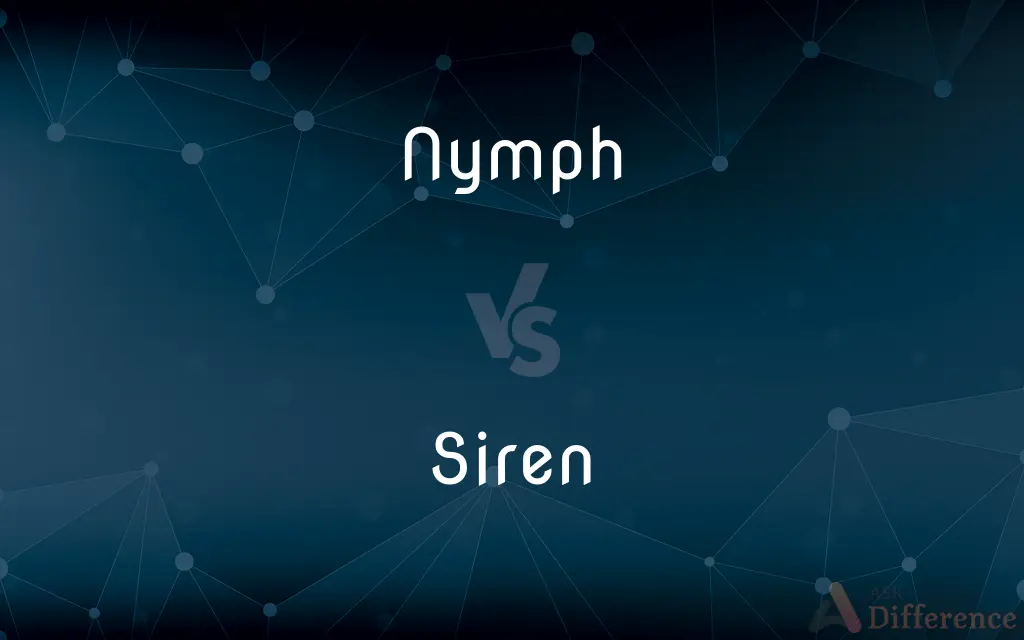Nymph vs. Siren — What's the Difference?
By Maham Liaqat & Urooj Arif — Updated on April 26, 2024
Nymphs are mythological spirits of nature, often depicted as benevolent, whereas sirens are creatures from Greek mythology known for luring sailors to destruction with their enchanting music.

Difference Between Nymph and Siren
Table of Contents
ADVERTISEMENT
Key Differences
Nymphs, often associated with specific natural locales such as forests, rivers, or mountains, embody the essence of the natural world, showcasing a nurturing and gentle aspect. In contrast, sirens are sea creatures whose main attribute is their irresistibly beautiful singing voice, which they use to seduce and lead sailors astray.
Nymphs are depicted across various myths as benign, interacting with gods and humans, often in supportive roles, enhancing the natural beauty and fertility around them. Sirens, on the other hand, are considered malevolent, their interactions with humans usually having fatal consequences due to their deceptive nature.
In art and literature, nymphs are portrayed in numerous forms but generally as beautiful, ethereal maidens who are lovers of dance and music. Whereas sirens are traditionally depicted as having a bird's body with a woman's head, later representations show them as mermaid-like figures, emphasizing their connection to perilous waters.
Nymphs have a broader role in mythology, partaking in tales that range from the romantic to the tragic, symbolizing the life-giving aspect of nature. Sirens are more singular in their mythological function, primarily appearing in stories like those of Odysseus, serving as warnings of the dangers of temptation.
The origins of nymphs are deeply rooted in Greek mythology, and they are considered lesser deities, reflecting various aspects of the natural world. Sirens, originally conceived in Greek myths, have been integrated into Western culture as synonymous with any alluring but hazardous entity.
ADVERTISEMENT
Comparison Chart
Mythological Role
Spirits of nature
Creatures that lure sailors
Depiction
Benevolent, nurturing
Malevolent, seductive
Typical Representation
Beautiful maidens
Birds with women's heads or mermaids
Symbolism
Nature, fertility
Temptation, danger
Cultural Origin
Greek mythology
Greek mythology
Compare with Definitions
Nymph
Often featured in folklore and stories about the natural world.
Tales of woodland nymphs are common in local folklore.
Siren
Appears in many stories and warnings about the dangers of seduction and temptation.
He referred to the deceptive investment as a siren's call.
Nymph
A mythological spirit associated with nature, often depicted as a beautiful maiden.
The forest nymphs danced under the moonlight.
Siren
A creature from Greek mythology known for luring sailors with her enchanting music.
The siren's song tempted many a sailor to his doom.
Nymph
Represents natural elements like water, trees, or mountains.
River nymphs were said to inhabit the stream's sparkling waters.
Siren
Represents the perilous and deceptive aspects of the sea.
Sailors often wore wax in their ears to avoid hearing the siren's deadly song.
Nymph
Appears in various mythological narratives interacting with gods and humans.
In mythology, nymphs often assist heroes on their quests.
Siren
Often depicted as having a beautiful but deadly nature.
Like a siren, she was both mesmerizing and dangerous.
Nymph
Symbolic of growth, fertility, and the benign forces of nature.
Gardeners once believed nymphs helped plants grow.
Siren
A term used metaphorically to describe anything that is irresistibly attractive but potentially harmful.
The promise of fast profits was a siren song to the inexperienced investors.
Nymph
A nymph (Greek: νύμφη, nýmphē; Ancient: [nýmpʰɛː], Modern: [nímfi]) in ancient Greek folklore is a minor female nature deity. Different from Greek goddesses, nymphs are generally regarded as personifications of nature, are typically tied to a specific place or landform, and are usually depicted as beautiful maidens.
Siren
Greek Mythology One of a group of sea nymphs who by their sweet singing lured mariners to destruction on the rocks surrounding their island.
Nymph
A mythological spirit of nature imagined as a beautiful maiden inhabiting rivers, woods, or other locations
The idyllic world of nymphs and shepherds
A wood nymph
Siren
Siren A woman regarded as irresistibly alluring.
Nymph
An immature form of an insect that does not change greatly as it grows, e.g. a dragonfly, mayfly, or locust.
Siren
A device in which compressed air or steam is driven against a rotating perforated disk to create a loud, often wailing sound as a signal or warning.
Nymph
A mainly brown butterfly that frequents woods and forest glades.
Siren
An electronic device producing a similar sound as a signal or warning
A police car siren.
Nymph
Greek & Roman Mythology Any of numerous minor deities represented as beautiful maidens inhabiting and sometimes personifying features of nature such as trees, waters, and mountains.
Siren
Any of several slender aquatic salamanders of the family Sirenidae of eastern North America, having external gills, small forelimbs, and no hind limbs.
Nymph
The eight-legged immature form of certain arachnids, such as ticks and mites.
Siren
(Greek mythology) One of a group of nymphs who lured mariners to their death on the rocks.
Nymph
Any female nature spirit associated with water, forests, grotto, wind, etc.
Siren
One who sings sweetly and charms.
Nymph
A young girl, especially one who is attractive, beautiful or graceful.
Siren
A dangerously seductive woman.
Nymph
(entomology) The larva of certain insects.
Siren
(biology) A member of an order of mammals of Sirenia.
Nymph
(entomology) Any of various butterflies of the family Nymphalidae.
Siren
(biology) A member of a genus of aquatic salamanders of the family Sirenidae, commonly used for all species subsumed under the family of Sirenidae.
Nymph
A goddess of the mountains, forests, meadows, or waters.
Where were ye, nymphs, when the remorseless deepClosed o'er the head of your loved Lycidas?
Siren
(entomology) Any of various nymphalid butterflies of the genus Hestina.
Nymph
A lovely young girl; a maiden; a damsel.
Nymph, in thy orisonsBe all my sins remembered.
Siren
A device, either mechanical or electronic, that makes a piercingly loud sound as an alarm or signal, or the sound from such a device (first recorded 1879).
Nymph
The pupa of an insect; a chrysalis.
Siren
(music) A musical instrument, one of the few aerophones in the percussion section of the symphony orchestra (patented as Acme Siren in 1895).
Nymph
Any one of a subfamily (Najades) of butterflies including the purples, the fritillaries, the peacock butterfly, etc.; - called also naiad.
Siren
An instrument for demonstrating the laws of beats and combination tones.
Nymph
(classical mythology) a minor nature goddess usually depicted as a beautiful maiden;
The ancient Greeks believed that nymphs inhabited forests and bodies of water
Siren
An astrophysical event that can be used for calculating cosmic distances.
Nymph
A larva of an insect with incomplete metamorphosis (as the dragonfly or mayfly)
Siren
To make a noise with, or as if with, a siren.
Nymph
A voluptuously beautiful young woman
Siren
Relating to or like a siren.
Siren
One of three sea nymphs, - or, according to some writers, of two, - said to frequent an island near the coast of Italy, and to sing with such sweetness that they lured mariners to destruction.
Next where the sirens dwell you plow the seas;Their song is death, and makes destruction please.
Siren
An enticing, dangerous woman.
Siren
Something which is insidious or deceptive.
Consumption is a siren.
Siren
A mermaid.
Siren
Any long, slender amphibian of the genus Siren or family Sirenidæ, destitute of hind legs and pelvis, and having permanent external gills as well as lungs. They inhabit the swamps, lagoons, and ditches of the Southern United States. The more common species (Siren lacertina) is dull lead-gray in color, and becames two feet long.
Siren
An instrument for producing musical tones and for ascertaining the number of sound waves or vibrations per second which produce a note of a given pitch. The sounds are produced by a perforated rotating disk or disks. A form with two disks operated by steam or highly compressed air is used sounding an alarm to vessels in fog.
Siren
Of or pertaining to a siren; bewitching, like a siren; fascinating; alluring; as, a siren song.
Siren
A sea nymph (part woman and part bird) supposed to lure sailors to destruction on the rocks where the nymphs lived;
Odysseus ordered his crew to plug their ears so they would not hear the Siren's fatal song
Siren
A woman who is considered to be dangerously seductive
Siren
A warning signal that is a loud wailing sound
Siren
An acoustic device producing a loud often wailing sound as a signal or warning
Siren
Eel-like aquatic North American salamander with small forelimbs and no hind limbs; have permanent external gills
Common Curiosities
What are the main differences between nymphs and sirens?
Nymphs are benevolent nature spirits in mythology, while sirens are dangerous creatures known for their deadly allure.
What is the typical habitat of nymphs compared to sirens?
Nymphs inhabit various natural settings like forests and rivers, while sirens are associated with the sea.
Do nymphs interact with other mythological characters?
Yes, nymphs frequently interact with gods, goddesses, and mortals in mythology.
How do sirens use their abilities in mythology?
Sirens use their enchanting voices to lure sailors to their deaths, often causing shipwrecks.
What cautionary tales involve sirens?
The most famous tale involving sirens is their encounter with Odysseus, who had to take special precautions to save his crew from their song.
Can nymphs and sirens be considered similar in any aspect?
Both are mythological female entities associated with natural elements, but their roles and symbolism are distinctly different.
What is the symbolic significance of sirens in mythology?
Sirens symbolize the dangerous temptations that can lead one astray, particularly warning of the perils of overindulgence or deception.
Are there similar creatures to sirens in other cultures?
Yes, many cultures have myths about creatures that lure humans to their deaths with their voices or beauty, such as the Lorelei in German folklore.
Do modern interpretations of nymphs differ from ancient ones?
Modern interpretations often emphasize their connection to environmental themes, whereas ancient narratives focused on their interactions with gods and mortals.
Are there different types of nymphs?
Yes, there are several types of nymphs, including naiads (water nymphs), dryads (tree nymphs), and oreads (mountain nymphs).
What role do nymphs and sirens play in modern culture?
Nymphs often symbolize environmental protection and natural beauty, while sirens are used metaphorically to represent danger disguised as allure.
What literary works feature sirens?
Sirens are featured in Homer's "Odyssey" and various other literary and poetic works.
How do nymphs and sirens differ in their influence on humans?
Nymphs typically influence humans by enriching the natural world around them, while sirens exert a destructive influence through deception.
How are nymphs and sirens depicted in art?
Nymphs are typically shown as youthful and graceful women, while sirens have been depicted both as part bird and part woman, or as mermaid-like figures.
Can nymphs and sirens be seen in a positive light?
Nymphs are generally seen positively as embodiments of nature's beauty and generosity, whereas sirens, though fascinating, are usually viewed negatively due to their harmful actions.
Share Your Discovery

Previous Comparison
Cytoplasm vs. Nucleoplasm
Next Comparison
Plasticizer vs. SuperplasticizerAuthor Spotlight
Written by
Maham LiaqatCo-written by
Urooj ArifUrooj is a skilled content writer at Ask Difference, known for her exceptional ability to simplify complex topics into engaging and informative content. With a passion for research and a flair for clear, concise writing, she consistently delivers articles that resonate with our diverse audience.













































